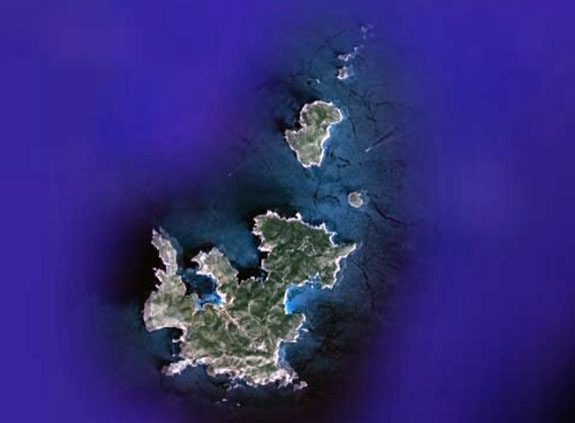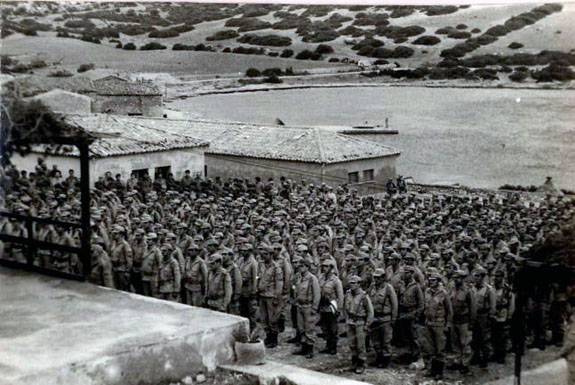
There are 14 National Parks in Spain, but only one of them is here in the Balearic Isles: Cabrera. The official name of it is Parque Nacional del Archipiélago de Cabrera (Castellano), or Parc Nacional de l’Arxipèlag de Cabrera (Catalan). The archipelago of Cabrera is made up of eleven islands and islotes: Estells de Fora, L’imperial, Cabrera, Illa de ses Bledes, Na Redona, Conillera, L’Esponja, Na Plana, Illot Pla, Na Pobra and Na Foradada, with Cabrera and Conillera being the two largest ones by far. The archipelago is situated some 10 km (5 nautical miles) south of Cap de ses Salines and has a total extension of some 1.3 ha of land and some 8.7 ha of maritime area.
The photo (top) shows the Port de Cabrera with the Castell de Cabrera. The photo (below) shows an arial view of the archipelago.

Remains of a Paleochristian monastery from the year 398 were found in the area of Clot des Guix. During the 13th century Cabrera was used by Berber pirates as a safe haven and hiding place; they used this hideout for attacking passing ships as well as assaulting the coasts of Mallorca. During the 14th century, a tower was built and later expanded into a fortification and, ultimately, into what now remains of the Castell de sa Cabrera. During the Napoleonic Wars (1808-1814) Cabrera was used by Spain as a prison camp to intern French soldiers. Some sources claim that more than 12,000 soldiers were kept in camps during those six years. Most of the prisoners perished in the harsh conditions with little water, insufficient food and hot temperatures; only some 3,600 soldiers are said to have survived, whilst two out of three died in the name of France. A monument on the island of Cabrera pays tribute to the perished French soldiers. The nation of Spain has more than some blame to take for this sad episode.
During the 19th century, the archipelago passed into private hands but in 1916, during the World War I, the group of islands was expropriated and requisitioned by the nation for defense reasons. Some sources have it that Joan March Ordinas was involved in this manoeuver for his own sinister gains. Cabrera was used as a military zone from 1916 up until the 1980s.
In 1991 Cabrera was declared a Parque Nacional Marítimo y Terrestre, still under central government rule in Madrid.
Three weeks ago, however, was an historic day, when on July 1st the administration of the archipelago passed from the Madrid government to the Balearic Govern and the Conselleria de Medio Ambiente in Palma. From now on, any decision relating to the Parque Nacional del Archipiélago de Cabrera other than ownership is no longer a question for Madrid to ponder, but a purely Balearic matter. The photo (below) shows the Conseller de Medio Ambiente, Miquel Ángel Grimalt (right), hoisting the flag for his government and the Illes Balears.

Boat excursions to Cabrera are available daily – during the season – from Colònia de Sant Jordi, and also from Portopetro. The trips leave around 09h30 (please check) and take just under an hour. Boats return to Mallorca at around 17h00, thus giving you approximately five hours on the island of Cabrera. If you wish to visit with your own boat, it is necessary to get authorisation from the park administration. Up to fifty sailing permits are granted per day, though anchoring is prohibited during the night. It is also necessary to get a permit for scuba diving, and the park authorities will tell you where you can dive.
The photo (bottom) shows a contingent of Spanish soldiers stationed on Cabrera during the Sixties.

Even though I’ve been to Cabrera a couple of times and I certainly took a few photos, this was before I spent time blogging and before the digital age had started. So, I can offer no photos of my own making, I’m afraid. Instead, all four photos were borrowed from the Internet. Thanks are due (from the top) to Cayetano/Flickr, Wikipedia, the Diario de Mallorca and the Comandancia General de Balears.
Muchas gracias.


Your blog is a mine of information about Mallorca…have read a good few of your posts.
I, for one, appreciate all the time and effort that you have devoted to this project.
Thanks.
I am doing a project in spanish class about this national park and found your website very useful! Thanks.